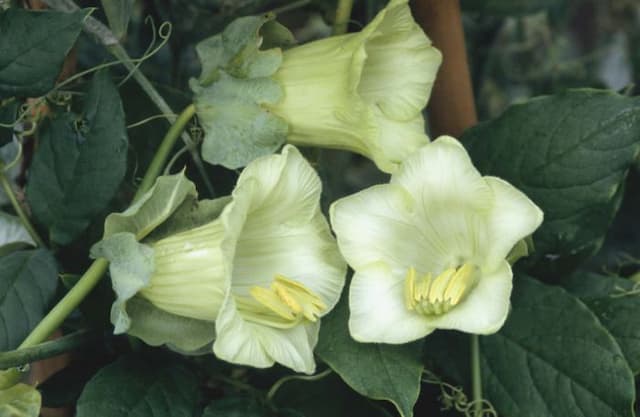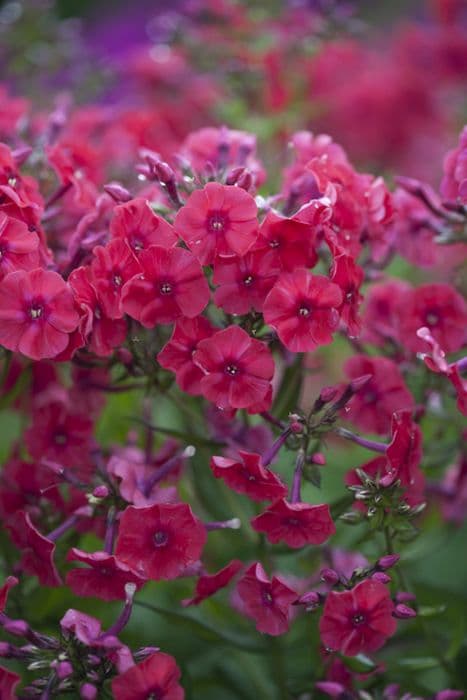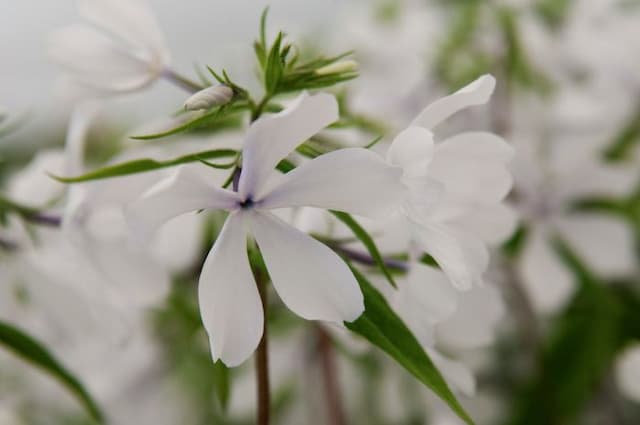Garden Phlox Phlox paniculata 'Harlequin' (v)

ABOUT
Phlox paniculata 'Harlequin' is a vibrant and eye-catching perennial garden phlox known for its variegated foliage and showy flowers. The plant is characterized by its leaves, which are unique in their appearance, boasting a bright cream or yellow margin that surrounds a rich green center, giving off a striking contrast that adds interest even when the plant is not in bloom. The flowers of the 'Harlequin' variety are equally remarkable. They gather in large, rounded clusters at the top of the stems, creating a bold display of color. Individual flowers are typically shaped like small trumpets, with a tube base flaring out into five rounded, petal-like lobes. The color of the flowers is usually a deep pink or purplish-pink, often with a lighter or white eye in the center, adding depth and dimension to the flower heads. The overall aspect of Phlox paniculata 'Harlequin' is lush and full, with multiple stems rising from the ground and forming a bushy appearance. The combination of the variegated leaves and the dense clusters of flowers makes this plant a standout in any garden setting, providing a bright splash of color and a touch of elegance throughout its blooming period.
About this plant
 Names
NamesFamily
Polemoniaceae
Synonyms
Garden Phlox, Summer Phlox, Perennial Phlox, Tall Phlox
Common names
Phlox paniculata.
 Toxicity
ToxicityTo humans
Garden Phlox is generally not considered toxic to humans. However, if ingested in large enough quantities, it could potentially cause mild stomach upset. The symptoms would likely be gastrointestinal in nature, such as nausea, vomiting, or diarrhea. While not usually a serious threat, anyone experiencing adverse effects after ingesting any part of the Garden Phlox plant should consult a healthcare provider.
To pets
Garden Phlox is not known to be toxic to pets. Ingesting this plant is unlikely to cause poisoning in cats, dogs, or other animals. Therefore, there are generally no associated symptoms of poisoning to be expected. If an animal does consume a large amount of the plant and exhibits signs of gastrointestinal upset, such as vomiting or diarrhea, it is advisable to contact a veterinarian.
 Characteristics
CharacteristicsLife cycle
Perennials
Foliage type
Deciduous
Color of leaves
Variegated
Flower color
Pink
Height
2-4 feet (60-120 cm)
Spread
2-3 feet (60-90 cm)
Plant type
Herb
Hardiness zones
4-8
Native area
North America
Benefits
 General Benefits
General Benefits- Attracts Pollinators: Phlox paniculata 'Harlequin' is known to attract bees, butterflies, and other beneficial insects, helping to pollinate gardens and support biodiversity.
- Aesthetic Appeal: With its striking variegated foliage and vibrant flowers, the plant adds visual interest and beauty to any garden space.
- Fragrance: The flowers of garden phlox emit a delightful fragrance that can add a pleasant sensory dimension to the garden experience.
- Drought Tolerance: Once established, Phlox paniculata 'Harlequin' can tolerate periods of drought, making it suitable for climates with occasional water shortages.
- Long Blooming Season: The plant has a lengthy blooming period during the summer months, providing color for an extended time.
- Versatile Landscaping: Garden phlox can be used in a variety of landscaping applications, including borders, flower beds, and as a backdrop for other plants.
- Cut Flowers: The blooms make excellent cut flowers for indoor arrangements, lasting well in a vase.
 Medical Properties
Medical PropertiesThis plant is not used for medical purposes.
 Air-purifying Qualities
Air-purifying QualitiesThis plant is not specifically known for air purifying qualities.
 Other Uses
Other Uses- Summer Garland Material: Phlox paniculata 'Harlequin' can be used to create colorful garlands or wreaths for summer festivals or garden parties due to their vibrant flowers and long stems.
- Photography Prop: The distinct variegated foliage and bright flowers provide an attractive background for macro or garden photography.
- Natural Fabric Dyes: The petals of the Phlox paniculata 'Harlequin' could potentially be used to create natural fabric dyes, though this use is more experimental and less common.
- Edible Flower Garnish: While not commonly known for culinary uses, the flowers of Phlox can sometimes be used as a decorative, edible garnish on salads or desserts, provided they haven't been treated with pesticides.
- Garden Themed Artwork: Artists may use pressed or dried phlox flowers to create botanical artwork, or use their image as inspiration for paintings and illustrations.
- Educational Tool: Gardeners and educators can use Phlox paniculata 'Harlequin' to teach about plant variegation, as its leaves provide a clear example.
- Fragrance Extraction: While not a common practice, the flowers could be used to extract natural scents for perfumes or potpourri, contributing a subtle fragrance.
- Butterfly Garden Display: Due to its attractiveness to butterflies, Phlox paniculata 'Harlequin' serves as an excellent choice for educational butterfly gardens or conservation projects focusing on pollinators.
- Soil Erosion Control: Though primarily an ornamental plant, Garden Phlox can be planted on slopes or areas where soil erosion is a concern, as its root system helps to hold the soil in place.
- Creative Writing Prompt: The striking appearance of the Phlox paniculata 'Harlequin' can be used as a visual prompt to inspire poets and writers for their creative works.
Interesting Facts
 Feng Shui
Feng ShuiThe garden phlox is not used in Feng Shui practice.
 Zodiac Sign Compitability
Zodiac Sign CompitabilityThe garden phlox is not used in astrology practice.
 Plant Symbolism
Plant Symbolism- Harmony - Phlox signifies harmony, representing the plant's ability to grow in clusters with its flowers harmoniously poised atop sturdy stems.
- Unity - Since Phlox paniculata commonly blooms in dense groups, it symbolizes the unity and togetherness found in close-knit communities.
- Proposal - In the language of flowers, the Phlox suggests a proposal or an offer coming with sweet intentions, reflecting the sweet fragrance of the Phlox flowers.
- Agreement - Phlox also stands for agreement, hinting at a mutual understanding or concord between people, much like the uniform bloom formations of the flowers.
 Water
WaterThe Garden Phlox should be watered deeply enough to moisten the soil to a depth of at least one inch. This typically equates to about one gallon for mature plants in a garden setting every week during the growing season, depending on weather conditions. Overhead watering should be avoided to reduce the risk of fungal diseases; instead, water at the base of the plant. During periods of drought or extreme heat, the frequency may need to increase to twice a week. Always ensure the soil around the Phlox is moist but not saturated, as they prefer evenly moist soil.
 Light
LightGarden Phlox thrives in full sun to partial shade conditions. It performs best when it receives at least six hours of direct sunlight each day. An ideal spot would be in a sunny border with some afternoon shade in hotter climates to prevent the foliage from scorching. However, too much shade can lead to leggy growth and poor flowering, so ensure a balance of light is maintained.
 Temperature
TemperatureGarden Phlox prefers temperate climates and can generally tolerate temperatures as low as 0°F and as high as 85°F. However, for optimal growth, a range of 60°F to 75°F is ideal. These plants are hardy in USDA zones 4 through 8 and can withstand occasional fluctuations outside their comfort range if properly acclimated.
 Pruning
PruningPrune Garden Phlox in early spring to remove any dead or broken stems, which encourages healthy new growth. Deadhead spent flowers continuously throughout the summer to promote further blooming and prevent self-seeding, which can lead to over-crowded planting conditions. After the first hard frost in fall or before new growth begins in spring, cut the plants back by one-half to one-third to maintain a tidy appearance and support vigorous growth.
 Cleaning
CleaningAs needed
 Soil
SoilThe best soil mix for Garden Phlox is a rich, moist, well-drained soil with a pH of 6.5 to 7.0. Incorporate organic matter such as compost or peat moss to improve drainage and fertility.
 Repotting
RepottingGarden Phlox does not typically require repotting as it is a perennial garden plant that is grown outdoors and not in containers.
 Humidity & Misting
Humidity & MistingGarden Phlox thrives best in outdoor conditions where the humidity is naturally provided by the environment; they do not require specific humidity levels.
 Suitable locations
Suitable locationsIndoor
Plant in a bright spot with moist, well-draining soil.
Outdoor
Full sun to partial shade, moist well-drained soil.
Hardiness zone
4-8 USDA
 Life cycle
Life cycleHarlequin Summer Phlox begins its life cycle as a seed, which when sown germinates in warm, moist soil conditions typically in late spring or early summer. Upon germination, the seedling emerges, developing true leaves and gradually maturing into a young plant. As a perennial, it establishes a root system that will allow it to return year after year, with vegetative growth resuming in spring after dormancy during the cold months. During the growing season, the plant elongates and forms a bushy structure that will eventually bear clusters of variegated foliage and fragrant, showy flowers by mid to late summer, attracting pollinators like butterflies and hummingbirds. After flowering, seed capsules may form, dispersing seeds for new plants to grow; mature plants can also be propagated by division. With the onset of autumn and cooler temperatures, the aerial parts of the plant die back, and it enters a period of dormancy, conserving energy within its root system until the next spring.
 Propogation
PropogationPropogation time
Spring to Summer
Propogation: Garden Phlox, or Phlox paniculata 'Harlequin', is best propagated through division, typically done in early spring before new growth begins. This process involves digging up an established clump of the phlox and gently separating it into smaller sections by hand or with a knife, making sure each new section has a good root system and at least one or two shoots. These divisions can be replanted at the same soil depth they were previously growing at, spaced about 18 to 24 inches (45 to 60 centimeters) apart to accommodate future growth. Water the new divisions thoroughly after planting to help establish them. Division not only helps to propagate the phlox but also revitalizes older plants that may have become woody or less vigorous over time.









